Yes, yes, yes to the idea of dredging Mirror Pond first and then trying to figure out the long-term picture later.
It was refreshing to hear that notion stated so directly by members of the steering committee working on this question.
“Something has to be done to remove the sediment immediately, regardless of what we do in the long term,” said Matt Shinderman, Oregon State University-Cascades Campus natural resources instructor.
“It’s kind of a two-stage process. The first is to dredge the pond, and the second is to do a longer-term study of what needs to be done to the pond,” said Don Horton, executive director of Bend Park & Recreation District.
Yes, indeed.
Earlier plans to spend $500,000 on a study of options faltered because the price was so high and no one had the money to pay for it. Estimates to dredge the pond range from $2 million to $5 million.
The group is awaiting citizen response from an upcoming park district survey before deciding if it should ask voters for a one-time bond issue to dredge the pond, or the formation of a permanent special taxing district.
A permanent taxing district is a complex question. Voters would need to consider whether they want to continue to carve out special tax obligations as they have for other things — such as the library and sheriff’s office — that previously were paid for by the general fund. And, voters wouldn’t know exactly what they’d get in the future with that obligation. Recommendations to return the river to its natural state, for example, would be far less popular than preserving the town’s crown jewel by dredging.
We favor a simple bond measure, because we think voters will support something they value and can understand.
Source: The Bulletin
